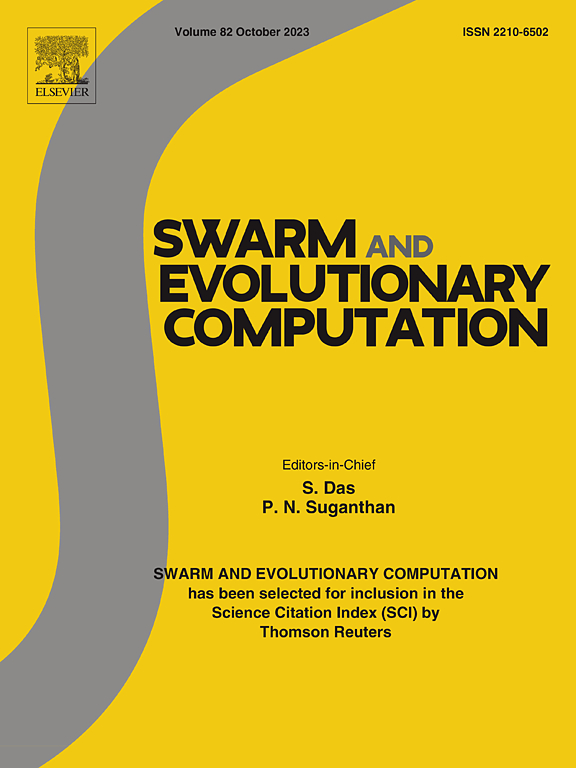约束多目标优化的双种群双阶段分解框架
IF 8.5
1区 计算机科学
Q1 COMPUTER SCIENCE, ARTIFICIAL INTELLIGENCE
引用次数: 0
摘要
约束多目标优化的主要挑战是同时在可行性、收敛性和多样性之间取得良好的平衡。然而,现有的大多数方法都存在不平衡性,难以在保持可行解多样性的情况下收敛到Pareto-optimal front (PF)。针对这一问题,本文基于多目标到多目标分解框架(M2M),提出了一种新的双种群双阶段约束多目标优化算法DD-M2M。在这种方法中,称为CP和DP的双重种群被协同使用。更具体地说,在第一阶段,DP在不考虑约束的情况下独立发展,只关注向无约束的PF收敛,而CP在基于可行性的环境选择规则的驱动下与DP弱协作发展。在第二阶段,双种群在M2M框架内被划分为多个子种群,以强协作的方式产生后代,最终在保证解多样性的同时收敛到受限的PF。在两个广泛使用的测试套件上的实验结果充分证明了DD-M2M在大多数测试问题上相对于7种最先进的方法的优越性。此外,将该方法应用于实际问题,实验结果证实了该方法在解决实际挑战方面的有效性。本文章由计算机程序翻译,如有差异,请以英文原文为准。
A decomposition framework with dual populations and dual stages for constrained multi-objective optimization
The main challenge of constrained multi-objective optimization involves achieving a good balance among feasibility, convergence, and diversity simultaneously. However, most existing methods exhibit an imbalance, making it hard to converge towards Pareto-optimal front (PF) while maintaining the diversity of feasible solutions. To address this issue, this paper proposes a new dual-population and dual-stage constrained multi-objective optimization algorithm, denoted as DD-M2M, based on the multi-objective-to-multi-objective decomposition framework (M2M). In this approach, dual populations, referred to as and , are employed collaboratively. More specifically, in the first stage, the evolves independently without considering constraints, focusing solely on convergence towards the unconstrained PF, while the evolves with a weak collaboration with the , driven by feasibility-based environment selection rules. In the second stage, the dual populations are both divided into multiple sub-populations within the M2M framework, generating offspring in a strongly collaborative manner to eventually converge to the constrained PF while ensuring solution diversity. Experimental results on two widely-used test suites fully demonstrate the superiority of DD-M2M compared to seven state-of-the-art methods on most test problems. Additionally, the proposed method is applied to real-world problems, and experimental results confirm its effectiveness in addressing practical challenges.
求助全文
通过发布文献求助,成功后即可免费获取论文全文。
去求助
来源期刊

Swarm and Evolutionary Computation
COMPUTER SCIENCE, ARTIFICIAL INTELLIGENCEC-COMPUTER SCIENCE, THEORY & METHODS
CiteScore
16.00
自引率
12.00%
发文量
169
期刊介绍:
Swarm and Evolutionary Computation is a pioneering peer-reviewed journal focused on the latest research and advancements in nature-inspired intelligent computation using swarm and evolutionary algorithms. It covers theoretical, experimental, and practical aspects of these paradigms and their hybrids, promoting interdisciplinary research. The journal prioritizes the publication of high-quality, original articles that push the boundaries of evolutionary computation and swarm intelligence. Additionally, it welcomes survey papers on current topics and novel applications. Topics of interest include but are not limited to: Genetic Algorithms, and Genetic Programming, Evolution Strategies, and Evolutionary Programming, Differential Evolution, Artificial Immune Systems, Particle Swarms, Ant Colony, Bacterial Foraging, Artificial Bees, Fireflies Algorithm, Harmony Search, Artificial Life, Digital Organisms, Estimation of Distribution Algorithms, Stochastic Diffusion Search, Quantum Computing, Nano Computing, Membrane Computing, Human-centric Computing, Hybridization of Algorithms, Memetic Computing, Autonomic Computing, Self-organizing systems, Combinatorial, Discrete, Binary, Constrained, Multi-objective, Multi-modal, Dynamic, and Large-scale Optimization.
 求助内容:
求助内容: 应助结果提醒方式:
应助结果提醒方式:


